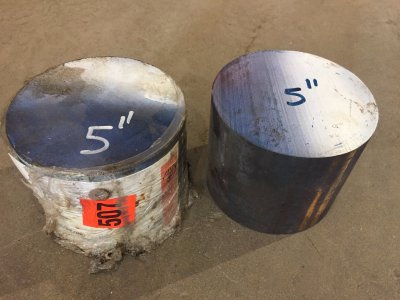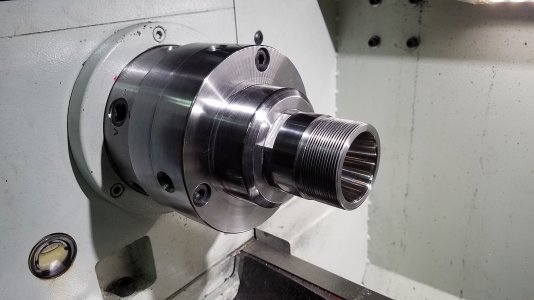- Joined
- Dec 24, 2020
- Messages
- 1,042
Hey all,
I put this in the beginner's section as I'm sure it's a pretty simple question. I'm repairing an old Charles Parker 975 vise for a buddy and need some advice. This is a 105lb vise that's at least 75 years old so most of the metal is a mystery other than the body being ductile iron most likely.
My buddy put a long cheater pipe (like 3-4ft) on the handle and broke the screw in half...he now knows cheater pipes on vises are a bad idea! He asked me to fix it, and that's a repair I've done in the past a number of times, but this one is a bit different. Normally I buy a length of all thread (square or Acme as needed) turn down one end so it's smooth, cut the old thread off the spindle head, then bore a hole in the spindle to match the turned down section, press the new screw into the bore then run a TIG bead around where the two meet. I usually also cross-pin by drilling through the spindle and through the new section of screw, drive a press fit pin in until it's slightly countersunk, then tack weld that with the TIG and then smooth it over. That gives me a weld bead and a pin to hold the two parts together...so far it's been perfect.
This vise has a screw that's an oddball size....call it 1.100" and 4TPI square thread. I haven't been able to find that, so I'm going to have to turn down some stock and cut the appropriate threads. I'm planning to use a grooving insert that's .189" since the groove is .190" or a touch bigger (I'm going to make more careful measurements before proceeding). Since I'm going to have a pretty long work piece and a fairly wide insert I'm looking for a steel that will be a bit easier to machine while still something I can weld successfully. I'm not particularly worried about the strength of the steel since I doubt anything special was used when it was made, and I've told him not to beat the heck out of his grandfather's vise again!
Feel free to comment if my plan sounds off. I already have plenty of mild steel in 1.25" and 1.5" round already (and maybe bigger) so I can do a test piece out of mild steel first if I wind up buying something different for the final product. I'm also in no rush, so there is zero pressure.
Anybody have a suggestion for what steel might make a good balance between machinability and weldability?
I put this in the beginner's section as I'm sure it's a pretty simple question. I'm repairing an old Charles Parker 975 vise for a buddy and need some advice. This is a 105lb vise that's at least 75 years old so most of the metal is a mystery other than the body being ductile iron most likely.
My buddy put a long cheater pipe (like 3-4ft) on the handle and broke the screw in half...he now knows cheater pipes on vises are a bad idea! He asked me to fix it, and that's a repair I've done in the past a number of times, but this one is a bit different. Normally I buy a length of all thread (square or Acme as needed) turn down one end so it's smooth, cut the old thread off the spindle head, then bore a hole in the spindle to match the turned down section, press the new screw into the bore then run a TIG bead around where the two meet. I usually also cross-pin by drilling through the spindle and through the new section of screw, drive a press fit pin in until it's slightly countersunk, then tack weld that with the TIG and then smooth it over. That gives me a weld bead and a pin to hold the two parts together...so far it's been perfect.
This vise has a screw that's an oddball size....call it 1.100" and 4TPI square thread. I haven't been able to find that, so I'm going to have to turn down some stock and cut the appropriate threads. I'm planning to use a grooving insert that's .189" since the groove is .190" or a touch bigger (I'm going to make more careful measurements before proceeding). Since I'm going to have a pretty long work piece and a fairly wide insert I'm looking for a steel that will be a bit easier to machine while still something I can weld successfully. I'm not particularly worried about the strength of the steel since I doubt anything special was used when it was made, and I've told him not to beat the heck out of his grandfather's vise again!
Feel free to comment if my plan sounds off. I already have plenty of mild steel in 1.25" and 1.5" round already (and maybe bigger) so I can do a test piece out of mild steel first if I wind up buying something different for the final product. I'm also in no rush, so there is zero pressure.
Anybody have a suggestion for what steel might make a good balance between machinability and weldability?



